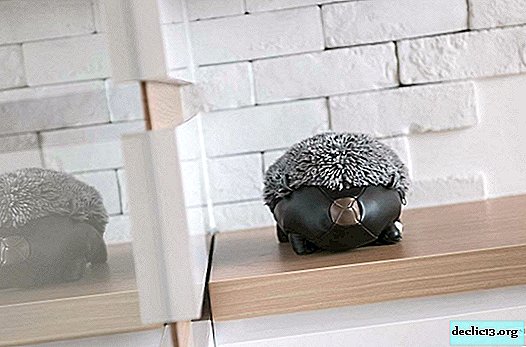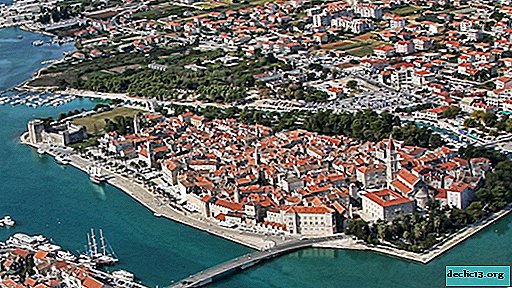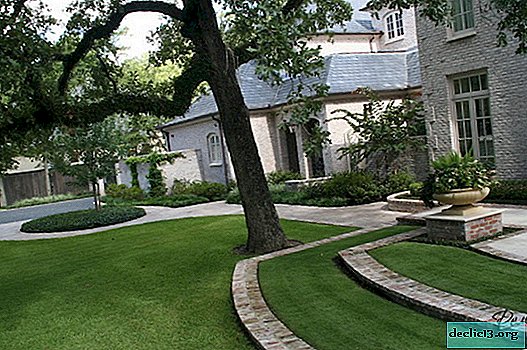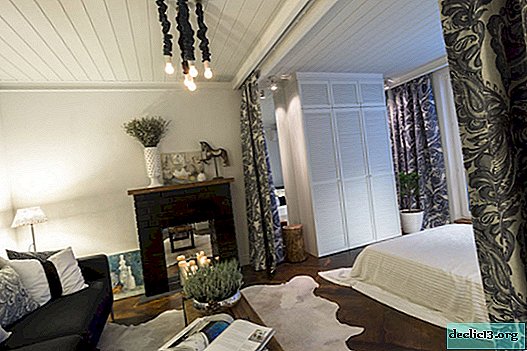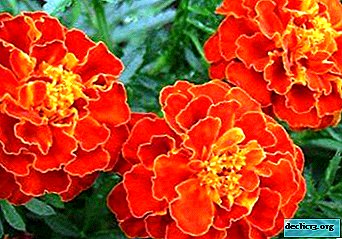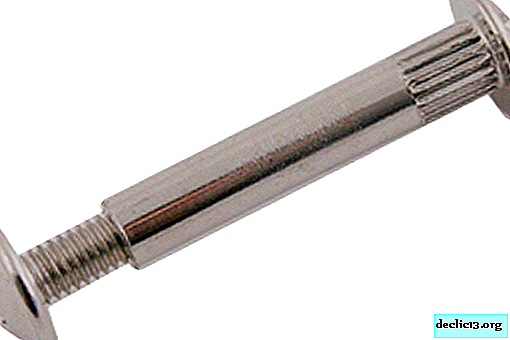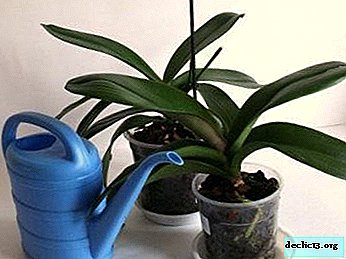We grow beauty with our own hands! Pelargonium Denise: photos and features of care
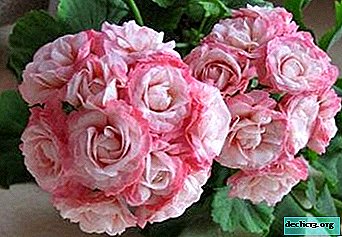
Among the perennial pelargoniums there are also their favorites - this is the variety Denise. This plant is the most desired flower for most lovers of pelargonium: Denise is appreciated for its exceptional external beauty, combined with unpretentiousness in care and maintenance.
In the article we will examine in detail the features of this pelargonium, learn how to plant it correctly, how to care for lush decorative flowering.
Description
As already mentioned above, Deniz pelargonium is one of the plants most loved by flower growers. Some of them call this variety Denis. Queues are literally lined up for the cuttings of this flower on thematic forums: flower growers are ready to lay out considerable amounts for the shoot. The plant belongs to the zonal rosebud varietiesTherefore, it has all the advantages of pelargonium similar to roses. Among all the rosaceous pelargonium, it is Denise that is considered the most spectacular and most perfect flower.
The plant is not very tall, unlike other rose-bearing species, but it still needs to form a bush. Note that pruning in this case must be done carefully, since Denise does not really like this procedure.Who is the creator of this variety is still so authentic and unknown. In addition, often sellers of cuttings for Denise give other rosebud varieties, only outwardly similar to this variety. Therefore, it is best to purchase a plant in a nursery - so there is less chance of running into a "fake" Denise.
Appearance
Pelargonium Denise took herself all the best from rosebud varieties: the plant simply impresses with its external beauty. Denise forms numerous pink buds collected in lush inflorescences. Externally, the inflorescences resemble the bouquets of the bride, as they are collected in a perfectly neat and decorative way.
The bushes of the plant, although not too tall, are quite strong and powerful. A properly formed bush is decorated with many inflorescences resembling lush hats. The buds are in the shape of roses that are not fully open. In the middle, the petals are light, and the lower ones are painted more intensely: such a gradient transition creates a very interesting effect.
Photo
And here is this sort of pelargonium in the photographs:



Landing
We learn what requirements Deniz Pelargonium has for its habitat and maintenance.
Location and Lighting
Pelargonium Denise, like all rosebuds, is a photophilous plant. At home, therefore, it is recommended to keep the flower on a sun-drenched window sill, and in summer you can take it out to the balcony, terrace, or even to the garden. Note that on a windowsill from direct sunlight Denise is better to shadeso that there are no burns on the leaves and stems, and when grown outdoors in the summer, such shading is not required.
Lack of light has a bad effect on the decorative qualities of the plant, leads to decay, yellowing of foliage, insufficiently flowering.Temperature
The plant feels good at moderate air temperatures, however, prolonged maintenance at too low a temperature negatively affects the plant’s health, and can be very harmful. The best option is to cultivate Denise in summer at a temperature of + 20-25 degrees, and in winter during dormancy - at + 12-15 degrees.
Priming
Pelargonium Denise needs a nutritious loose soil with a neutral acid reaction. Ready-made soil mixtures intended for geraniums and pelargoniums are sold in stores - in this case, they are the best fit.
 If you want to make a substrate yourself, then take the following components:
If you want to make a substrate yourself, then take the following components:
- peat land - 2 parts;
- sod - 2 parts;
- humus - 2 parts;
- sand - 1 part.
Do not forget to disinfect the self-prepared substrate, especially if the components for it were used from the street.
So that the soil does not get too wet, put a layer of drainage on the bottom of the pot in the form of expanded clay small pebbles, pebbles or broken bricks.
Care
Consider in detail the main points for caring for this plant.
Watering
Pelargoniums of rosebud varieties need regular, but not too plentiful watering. A plant will tolerate drought better than waterlogging, since in the latter case, its roots begin to rot very quickly.
It is recommended to water when the topsoil in the pot dries. Water more often in summer, and in winter, the procedure can only be carried out when the soil is already noticeably dry, but not completely.Denise does not need spraying: the problem of air humidity is not for her. Moreover, spraying and excessively moist air can be harmful to the plant, as they lead to the development of fungal diseases, rot.
Top dressing
So that Denise feels well and actively blossoms, regularly feed her with mineral complex additives. In spring, it is important to add nitrogen to the soil to form lush greenery, and at the beginning of flowering, switch to potash-phosphorus fertilizing to form lush inflorescences. In winter, Deniz does not need feeding pelargonium.
Pruning
This procedure is necessary for the plant, however, it suffers illiterate pruning Denise is not always good. Therefore, in order for the flower to respond positively to the procedure, several simple rules should be followed:
- prune a plant for the first time only after it has finally taken root and takes root;
- use only a well-sharpened and thoroughly sanitized cutting tool;
- to pinch as young shoots grow, so that more active lateral branching occurs;
- in the autumn after flowering to rid the plant of dried, weak and diseased branches.
Diseases and problems
Pelargonium Denise, although not too picky, however, can also be affected by diseases and pests. Next, we find out what problems arise when growing this flower most often, and how to cope with these problems.
Gray rot
 This disease most often threatens rosaceous pelargonium. You can understand that the plant is affected by rot, according to the gray fluffy coating that appeared on its leaves. Waterlogging of the soil and cool air temperature provoke the appearance of this disease.
This disease most often threatens rosaceous pelargonium. You can understand that the plant is affected by rot, according to the gray fluffy coating that appeared on its leaves. Waterlogging of the soil and cool air temperature provoke the appearance of this disease.
In order to cope with gray rot, it is necessary to inspect the plant and carefully remove all affected leaves. After this, pelargonium should be sprayed with a systemic fungicide.
Rust
This disease is also a common problem when growing Denise pelargonium. A symptom of the disease is the characteristic spots of brown, brown, rusty shades that appear on the leaves. The affected foliage is removed and the plant is treated with a fungicidal preparation.
Whitefly and Mealybug
These pests pose the greatest danger to Denise pelargonium. Whitefly larvae may already be present on a newly acquired plant, therefore Before buying, carefully inspect the pelargonium bush. If you see white eggs or larvae on the leaves, it is better to refuse the purchase, since it is quite difficult to remove the whitefly. The mealybug gives itself out as white, cotton-like, clusters in the deciduous sinuses.
Special systemic insecticides will help get rid of these pests. However, it is necessary to carry out the treatment as early as possible until the insects have caused irreparable damage to the plant.Lack of flowering
If the pelargonium Denise refuses to bloom, the reason may be the excessively warm winter content of the plant. Keep in mind that for the formation of healthy and abundant inflorescences in winter, Denise must be kept at a temperature of +12 to +15 degrees, not higher.
Breeding
Since Denise is Pelargonium rosea, the plant propagates exclusively by cuttings. The fact is that hybrid varieties of pelargonium are not able to transmit parental properties through seeds. That is, from the seed of Denise ordinary pelargonium will grow, but not rose-like.
In order for a full-fledged plant to grow from the handle, in this case it will take about a year. Although if you root the stalk in the spring, then for the first time it will bloom the same summer.
Experienced growers are advised to take stalks in March-February: however, if you have Denise alone, it is better to wait for the end of her flowering, and cut the stalk in the fall. In winter, the petioles are not cut, because in the conditions of short daylight a young plant is unlikely to fully develop.
Rooting Procedure Algorithm
 From the mother plant, the apical shoot is cut from five to seven centimeters long. It is necessary that the shoot has at least three internodes and at least four leaflets.
From the mother plant, the apical shoot is cut from five to seven centimeters long. It is necessary that the shoot has at least three internodes and at least four leaflets.- The stalk is dried in paper for one to two hours. Also, from its lower part (the one that will be underground), you need to cut off all the leaves and, if any, inflorescences. The last measure will protect the stalk from decay.
- Root shoot in a prepared moistened substrate (soil + sand / perlite), deepening one internode. It is recommended to place the container with the handle in a warm and well-lit place - for example, on a windowsill.
- With regular watering and adequate lighting, the stalk will take root in two to three weeks. If you take a transparent plastic cup for this task, then you can be sure of the rooting that took place.
Conclusion
We met with the most beautiful representative of rose-bearing pelargoniums - the variety Denise. This plant, along with a magnificent appearance, boasts an unpretentious character: special problems when growing plants do not arise. However, to comply with the requirements for plant placement and care, all the same, you need.
With regular care and optimal conditions of detention, Denise will appreciate the long and very beautiful, lush flowering.

 From the mother plant, the apical shoot is cut from five to seven centimeters long. It is necessary that the shoot has at least three internodes and at least four leaflets.
From the mother plant, the apical shoot is cut from five to seven centimeters long. It is necessary that the shoot has at least three internodes and at least four leaflets.